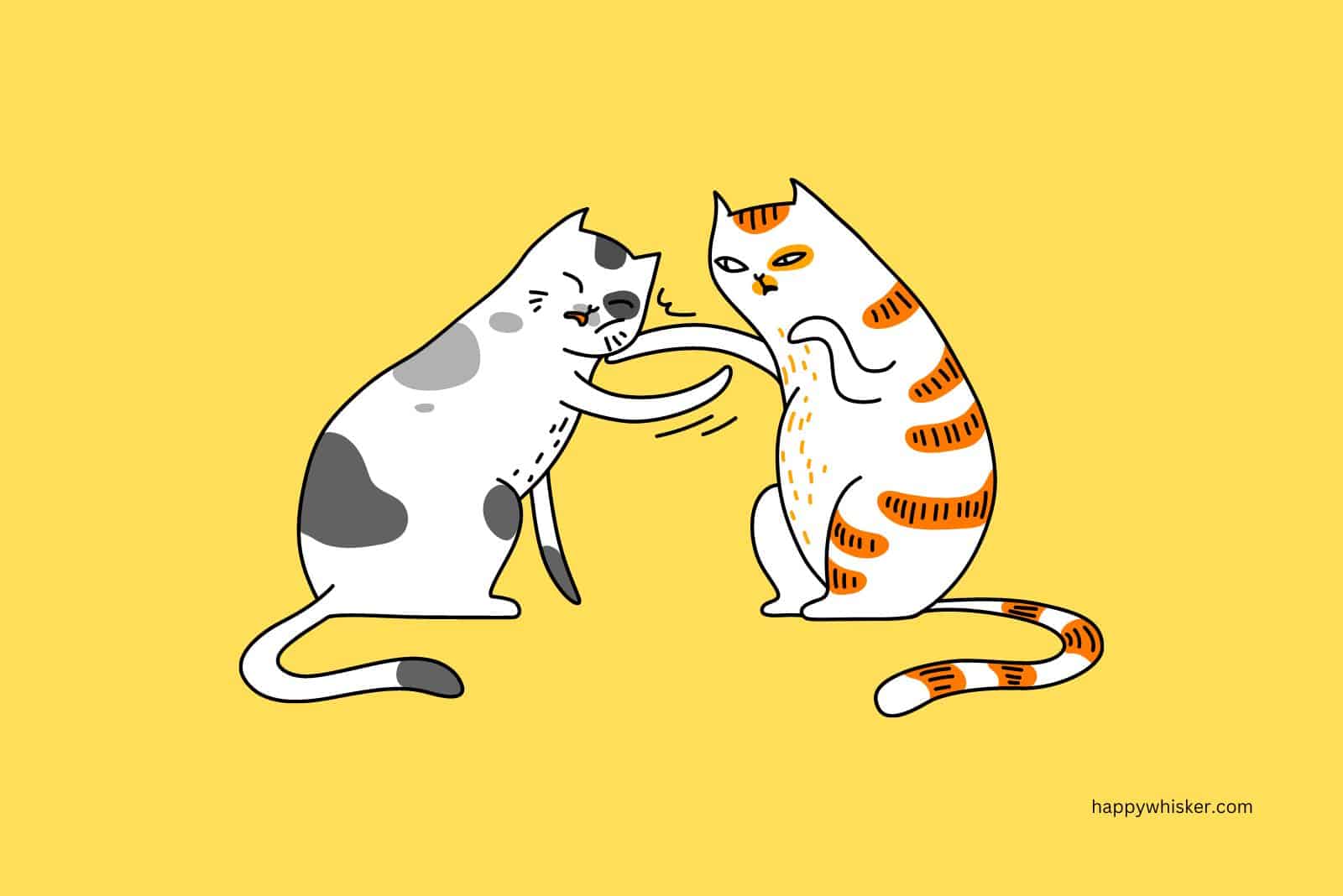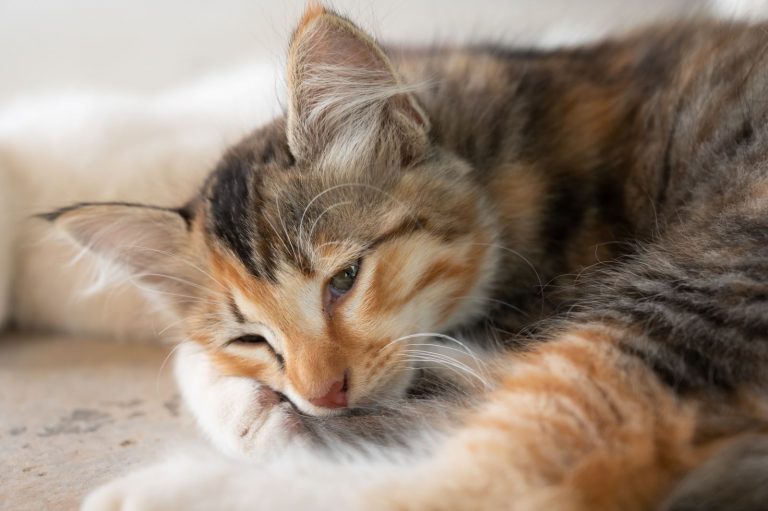Are My Cats Playing Or Fighting? This Is How I Found Out!

Perhaps you’ve adopted a new cat and you’re worried about your older cat accepting it, or you have two adult cats and you’re not sure if they are playing or fighting. Well, I had the same issue and question marks around my head: Are my cats playing or fighting?
After some time, you just know when your cats are playing and when there’s a real fight.
However, it takes some time, and until that happens, it’s good to learn about cat behavior and different methods of putting an end to play aggression and aggressive cat behavior.
I hope this article helps you understand when your cats are engaging in playtime, and when it’s getting serious. Also, I hope you’ll enjoy these cute pics I made for you.
How I Found Out Are My Cats Playing Or Fighting

Cats who are littermates are most likely playing all the time, they’re not that keen on fighting each other. There may be play bites, or they may even be pouncing on each other, but it’s all friendly.
However, once you adopt a cat and bring it to your house where you already have a cat, it might raise some issues.
I had a similar issue because every new cat had to be introduced and accepted by my cats who were already living in the house. Luckily, they are all such sweethearts and didn’t show any signs of aggression with the arrival of new furry friends.
I pay attention to them and their needs, and I always make sure that every cat has its own space and that they have a play session every day (be it privately with me, or together).
They get along really well, and we mostly play with a feather wand since they don’t mind chasing it together. Sometimes they put on a mock fight, which at first, was unusual and scary to me.
However, I talked to my cats’ veterinary technician and learned that there are some signs that will let me know whether my cats are playing or fighting. You can also get insight into cats’ aggression and fighting, from animal behaviorists on Pets WebMD.
Observe Your Cats’ Body Language
Your cat’s body language can be really helpful when it comes to a situation like this, when you have to ask yourself are my cats playing or fighting?
It can be hard to answer, since similar actions can be associated with both playing and fighting, for example, your cats chasing each other, jumping on each other, or even hissing at one another.
Cat owners often see their cats’ playtime as unfriendly, especially since cats sometimes also bite each other when they play. The best way to discern whether your cats are playing or fighting is to look at their body language.
Body Posture
For example, if their bodies are relaxed and their ears are turned forward, your cats are most likely playing. If you see your cats’ ears have flattened, or your cats puff their tails, it seems their ‘playtime’ has gone too far.
Another thing you may notice is your cat’s claws unsheathed. If your cats’ claws are retracted and they’re not showing, then everything is fine, but if they’re out, it’s probably because your cats are fighting.
Cat Bullies
These puffed-up, defensive postures, as well as leaning away from each other, indicate that your cats are now threatened by one another and are no longer happy playing.
Also, if one of your cats is chasing the other cat which is ill or tired at the moment, this is troubling. If one of your cats is trying to hurt the other one in any way, you must react.
Cat bullies are a real thing, so watch out that your bigger or physically stronger cat doesn’t “pick on” your skinnier, more fragile cat.
My Turkish Van once did this to my tabby cat, when they were both about 10 months old.
I heard my poor Mikey’s yelps for help, and the other one chased him around even though he wasn’t feeling alright. Luckily I put an end to it and put them both in separate rooms.
See also: Why Do Domestic Cats Growl? 8 Reasons For Cat Growling
How Is Your Cat’s Behavior Usually?
Observing your cats’ body language when they interact with one another outside their playtime might help you determine the severity of the situation when they happen to be fighting.
If your cats are grooming or licking each other, or snuggling, then they’re probably playing. However, scats may at some point feel threatened or ‘bullied’ and turn playtime into a fight.
When this happens, your cats will hiss, growl, or try to bite each other if they come too close. In these cases, you will also notice your cats are insecure, especially if they’re indoor cats and inexperienced in these ‘wild’ behaviors.
This can include spraying in unusual spots, pooping or peeing outside their litter box, or even aggressive behavior toward you.
In Case There Is A Fight…

If your cats are playing, then they’ll take turns being on top, so both cats will be on the top and the bottom equally.
The same thing goes for when they’re chasing one another; they will both chase each other the same. If your cats are play fighting they will stop their game and start again several times. This allows them to rest and switch places.
However, if your cats are fighting they will move quickly and they will not stop until one cat wins. If something like this happens, and you still don’t know whether they are just playing or fighting, watch how they act afterward.
If your cats fought, they’ll most likely avoid each other, or at least one (usually the defeated one) will avoid the other one.
But if they were playing, they’ll still be friendly to one another afterward, and return to their regular behavior. Your cats might even sleep next to each other.
End It!
When a cat fight breaks out, it’s better to keep them apart to minimize and avoid any injuries. Meanwhile, be careful not to be extremely forceful in breaking up a fight so you don’t get hurt either. Distract your cat by making loud noises or using toys.
This helps to divert their focus and put an end to their fight. Allow your cats to calm down before caressing or holding them to avoid more anxiety and violence. Remember, never break up a catfight with your hands.
Don’t risk being scratched or bitten, since one of them may rush toward your hands in the heat of the fight. Furthermore, one cat might spot you and turn its aggressive behavior toward you.
This may result in your cat being aggressive towards you in the long run as well, and I’m sure you don’t want this. If one of your cats happens to bite or scratch you severely, seek medical attention asap.
Cat bites can, and are frequently, contaminated with Pasteurella strains, which can cause cellulitis. Early therapy is the most effective method of prevention.
What Usually Causes Cat Fights

So, we’ve seen some differences in cat behavior when your cats are fighting and when they’re playing.
Let’s see some of the most common reasons for catfights in multi-cat households. This way, you’ll know more easily if your cats’ playtime has turned into a fight.
1. Cats Feel Like They Don’t Have Enough Space
If your cats, or one of them, believes that it must compete with the other cat for food or space in your house, there will likely be a fight. This problem increases if you live in a smaller house or apartment, and your cats don’t have much room to roam around.
2. One Cat Feels Anxious
If one cat feels irritated, scared, or anxious, it may express those feelings by starting a fight with your other cat. If your cats hear a loud noise, for example, they may get startled and attack each other out of impulse.
3. There Has Been A Change In Your Cats’ Routine
Cats are creatures of habit, and therefore everyday habits and schedules offer them a feeling of security and safety.
Having said that, if anything in their surroundings suddenly changes, such as guests staying for a long time or the arrival of new items, they may get agitated or intimidated.
4. A New Scent Has Entered The House
Cats that are in the same social group have a shared fragrance that helps them identify one another.
However, if one of them goes to the ‘great outdoors’ and comes back home smelling a whole lot different, your other cat will sense it. This often results in a fight.
5. In Case It Meets A Neighbor
If your cats are allowed to wander throughout your neighborhood, you may have seen your cat becoming threatened by your neighbor’s cat or other cats they encounter outside. On the other hand, you may have seen them start a fight with the other cat.
When unfamiliar cats collide, they are more inclined to give the other some space in order to prevent a fight. However, there may be occasions when one cat is very aggressive in establishing their territory, which could lead to a conflict.
Because cats are territorial, another cat invading their territory may cause them stress.
Preventing Your Cats From Becoming Fighting Cats

If your cats have engaged in a fight, let them cool off. After they’ve calmed down, see how they behave. Even if they’re all good (they probably won’t be right away), you need to find a way to make sure they don’t fight again.
Find the cause of their problem, and fix it. Let’s see what can be done to prevent future catfights!
#1 Make Sure Your Cats Have Enough Room
Always make sure that there is enough room for your cats to move around. Each cat should have its own water bowl and food bowl and of course a litter box for every cat.
However, buying many cat beds might not be necessary, since we all know how cats are (they’ll sleep in just about anything rather than a fluffy, expensive bed that’s specifically made for them, lol), so just let them pick their own sleeping spot.
Make sure there’s enough room for each cat you plan to adopt. If you do this, neither cat will feel like it has to fight for a spot in the house.
#2 Provide Cat Trees And Condos
You don’t necessarily have to buy condos or cat trees, but I did and it’s a great idea. You can provide them with DIY boxes or buy scratching posts, as long as it provides your cats with more sources for entertainment.
When cats feel threatened or when they just want to find a place to have some privacy, providing them with a cat condo or a high cat tree with different platforms and perches is a great thing.
Cats prefer vertical spots and spots where they can climb or hide. These spaces would provide your cats with a sense of safety as well.
Check out: Cat Tree That Looks Like A Tree – TOP 10 Product Reviews
#3 Consider Neutering
Cats who have not been neutered or spayed are more prone to aggressive behavior.
Unneutered males are especially known to run away and roam around the neighborhood. Neutering your cats helps to avoid this type of behavior and keeps them safe.
#4 Use Pheromone Diffusers
Pheromone diffusers emit an aroma that is similar to feline pheromones. This helps your cat cope with stress and undesired habits.
See also: Comfort Zone Vs Feliway: Which Pheromone Diffuser Is Better?
#5 Watch Out For Neighboring Cats

In order to avoid your cat feeling insecure or fighting with other cats for food or water, put their bowls in separate places. Put their litter boxes in separate rooms as well. Securing your windows helps keep neighbor cats out of your house.
Plus, you won’t have to worry about your cat being lost. In case your cat has already had a fight with a neighboring cat, speak with its owner if you feel comfortable doing so. The two of you can explore and find potential solutions to the problem.
You can try to plan when your cats can go outside so they don’t go out at the same time. I know my mom did this with her neighbor because they live in the suburbs and it is safe for her cat to roam around their block.
However, he got into a horrible fight with her neighbor’s cat and she rushed over there to demand a schedule! It was funny how she rushed over to his house, but it was a great solution. It keeps both your cats safe and without wounds.
#6 Keep Your Cats In At Night
This is mostly advised to cat parents whose cats are mostly indoor and especially if they’re spoiled. But it is great for all cats because it protects them from more dangerous cats and traffic accidents.
You might also be interested in: Why Is A Cat Crying Outside At Night And How Can I Stop It?
#7 Play And Bond With Your Cats
Playing with your cats allows them to express their true self and reduce tension. To keep them busy, you can also use interactive toys and DIY play objects.
Both physical and mental stimulation is beneficial for your cat, and playing allows them to release any pent-up energy.
#8 Re-Introduce Your Feline Friends
Be patient when introducing new cats so that they feel at ease in one other’s presence. Take your time and don’t rush it. First and foremost, keep them in different rooms. You can then first introduce them to each other’s smell.
After that, you can let them stay in the same area, but with a barrier (you can use a baby gate) to keep them safe. If you believe they are comfortable with each other, you can let them be without the barrier.
When they engage in a nice manner, reward their positive behavior. Allow them to become acquainted with one another in their own time. You can repeat these methods in case they fight in the future.
You might want to read: Warning Signs When Introducing Cats And How To Do It Properly!
Final Thoughts
To sum up, if you’ve asked yourself are my cats playing or fighting? The best way to know is to monitor their body language during playtime, or during their other time together.
If your cats are gentle with each other, they don’t make much noise and are relaxed, they’re playing.
When your cats are “play fighting” they won’t make loud noises (you might not even hear a meow), they won’t hurt each other, and they will take turns in whatever they’re doing. If they are chasing each other, they will take turns.
If they are biting, they’ll both bite and lick each other, which often ends in grooming each other. And after it’s all done, your cats will be relaxed and are likely to take a nap together.
If your cats are fighting, they’ll be louder, show aggressive behavior, piloerection, pawing at each other, hissing, growling, and you’ll notice their ears are flattened and tails puffed up.
Note: If your cats continue to fight after you’ve tried these methods for improving cat behavior, take your cat to a certified cat behaviorist for a solution.






